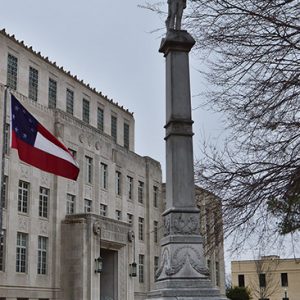calsfoundation@cals.org
Sebastian County Courthouse
aka: Fort Smith City Hall
The Sebastian County Courthouse stands at 100 South 6th Street, less than a mile from the Fort Smith National Cemetery, in the heart of the frontier city of Fort Smith (Sebastian County). The white, Art Deco–style courthouse is home to one of the county’s two seats of justice (the other is in Greenwood) as well as Fort Smith’s City Hall. This is the only public building in Arkansas that has this dual purpose. The Arkansas Historic Preservation Program recognizes the building for its historical significance due to its New Deal–era construction, as well as its architectural attributes. It was listed on the National Register of Historic Places on June 8, 1993.
After Sebastian County’s establishment in 1851, citizens of the centrally located town of Greenwood (Sebastian County) and of the more populated Fort Smith debated about which community should host the county seat. Possession exchanged for years, but in 1861, the state legislature divided the county into two judicial districts, thus making both cities into county seats, a situation that survives into the present day.
Various mercantile buildings in downtown Fort Smith hosted the Northern Judicial District for over a decade, until Sebastian County ordered the construction of a permanent courthouse. Architects Nier and Byram designed the four-story 1887 building that housed both county and municipal offices. The Victorian-era building, a grand structure with a tall clock tower, stood for half a century.
The New Deal–era program known as the Public Works Administration (PWA) appropriated funds for the new courthouse amounting to $495,548; the Manhattan Construction Company completed it under budget at $462,804. Sebastian County designated the 1887 courthouse as the site for the new building and demolished the old courthouse. Laborers began and finished PWA-financed project in 1937. The construction, along with other public works projects throughout Sebastian County such as a gymnasium in Greenwood and considerable roadwork throughout the county, kept the population economically stable through the Depression.
Fort Smith architects E. Chester Nelson, T. E. Bassham, and Carnall Wheeler designed the Art Deco–style courthouse with features common to other Art Deco courthouses in Arkansas: a boxy, symmetrical style; a projected entrance bay; and a partially marbled interior. Designers included the Fort Smith Police Department in the courthouse, although the city built a new facility for law enforcement in 1996.
There are several markers on the courthouse lawn, including the “Concrete Street 50 Year Service Award” erected in 1963. Granted by the Portland Cement Association, the marker notes that Fort Smith contained the most fifty-year-old concrete streets of any city in the United States at that time. Another maker from the Arkansas Centennial Commission in 1938 notes the history of Sebastian County.
The most striking feature of the courthouse lawn is the Confederate monument. A marble statue of a Confederate soldier stands on top of a granite shaft with its back to the Fort Smith National Cemetery, possibly a snub due to controversy over the monument’s placement. In 1902, citizens of Fort Smith and the local Daughters of the Confederacy, the Varina Jefferson Davis Chapter, wanted this monument placed in the national cemetery. Secretary of War Elihu Root objected to the presence of the monument (with its inscription, “Lest We Forget”)—which could be perceived as pro-Confederate—in a federal cemetery. Root suggested modifications, which triggered debate across Arkansas. In January 1903, the Fort Smith City Council settled the matter by moving the unaltered monument to the county courthouse grounds. A large crowd gathered on September 10, 1903, for the dedication ceremony, which included U.S. senator James H. Berry and uniformed Confederate war veterans.
For additional information:
“Courthouse and City Hall—Fort Smith, AR.” Living New Deal. https://livingnewdeal.org/projects/courthouse-and-city-hall-fort-smith-ar/ (accessed September 3, 2020).
“Fort Smith Confederate Monument.” National Register of Historic Places nomination form. On file at Arkansas Historic Preservation Program, Little Rock, Arkansas. Online at http://www.arkansaspreservation.com/National-Register-Listings/PDF/SB0481S.nr.pdf (accessed September 3, 2020).
“Fort Smith Oks paying $700,000.” Arkansas Democrat-Gazette, April 4, 1996, p. 1B.
Gill, John Purifoy, and Marjem Jackson Gill. On the Courthouse Square in Arkansas. N.p.: 1980.
“Sebastian County Courthouse/Fort Smith City Hall.” National Register of Historic Places nomination form. On file at Arkansas Historic Preservation Program, Little Rock, Arkansas. Online at http://www.arkansaspreservation.com/National-Register-Listings/PDF/SB0431.nr.pdf (accessed September 3, 2020).
Jared Craig
Arkansas Historic Preservation Program
 Early Twentieth Century, 1901 through 1940
Early Twentieth Century, 1901 through 1940 Historic Preservation
Historic Preservation Fort Smith Confederate Monument
Fort Smith Confederate Monument  Fort Smith Courthouses, 1896
Fort Smith Courthouses, 1896  Sebastian County Courthouse
Sebastian County Courthouse  Sebastian County Courthouse Entrance
Sebastian County Courthouse Entrance  Sebastian County Courthouse, Fort Smith
Sebastian County Courthouse, Fort Smith 



Comments
No comments on this entry yet.